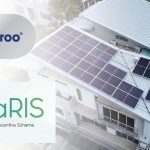


Solaroo partners With Two Leading BMW Dealers To Launch Nation’s First Rooftop Solar Programme
12th June 2023


Solar For Rakyat Incentive Scheme (SOLARIS)
1st April 2024Here’s a guide to help you understand your new TNB bill after installing a solar PV system under the Net Energy Metering Rakyat (NEM) policy.
Before Solar
Below is a sample electricity bill of our client, Mr. Chong, prior to the installation of a solar PV system. The bill illustrates the amount of electricity imported / consumed from the TNB’s grid.
Under Tempoh Bil (billing period) section we can see the billing summary.
A. Shows the Blok Tarif (kWh) (energy consumption/kWh) for the month, in Mr Chong’s bill, he has imported 688kWh to power up his home between 4 June – 4 July 2022.
B. Displays how much the energy consumption amounts to, under Amaun (RM) (amount/RM). The rates (Kadar/RM) for Blok Tarif (kWh) are set by TNB.
C. This section shows the final calculation of how much Mr Chong will be charged.
TNB Blok Tarif price + service charge (6%) + KTWBB (1.6%)
For the billing period stated above, Mr Chong will be charged RM273.22 for his home’s energy consumption, stated under Caj Semasa (current charge)
After Solar
Upon installing a solar PV system, you will notice a few changes on your TNB bill. There are three crucial terms to familiarise yourself with – Electricity Imported, Electricity Exported, and NEM Credit.
The term NEM is a policy in which the energy generated by your solar PV system will be consumed first. Any excess solar energy generated will be exported back to TNB as credits. The exported solar energy will then be used to offset any electricity imported in that same month.
This replaces the need for a battery storage system as any excess solar energy generated is accounted for by TNB as credits, giving you a “virtual battery storage”.
To elaborate this further, most homeowners will not fully consume their solar energy generated during the day due to being away from home for work, school, or any other reasons. Hence, their electricity usage during the day is quite minimum with a greater usage at night where more people are at home. During the day, the basic appliances which consume electricity should be powered by solar energy, with excess solar energy being exported back to TNB. During the night, as there is no solar generation, homeowners will be importing electricity from TNB. At the end of each month, TNB will calculate your total electricity imported and will deduct any excess solar energy which has been exported to TNB, resulting in only paying the net amount.
Let’s examine Mr Chong’s TNB bill at his new home after solar, as indicated in his electricity bill below:
-
A. This section displays the excess energy generated by Mr Chong’s solar PV system at home.
B. Shows the solar energy generated by Blok (kWh), for the month. In Mr Chong’s bill, he has generated 427kWh worth RM220.75.
C. This section shows the final calculation of how much Mr Chong will be charged after deduction of his energy generated against energy consumed. This section shows Mr Chong’s energy consumption for the month, which comes up to 711kWh or RM292.41. After deduction of his solar energy generated, he only has to pay RM65.62.
[(TNB Blok Tarif price + service charge (6%) + KTWBB (1.6%)] –
[Lebihan Tenaga yang Dijana + Caj Minimum Bulanan NEM]
For the billing period stated above, after deduction of his solar generation, Mr Chong will be charged RM65.62.
Baki NEM (Excess NEM credits)
Also, if the energy exported exceeds the energy imported from the TNB grid, the surplus credit will be carried forward to the following month, which will displayed on TNB bill as Baki Nem (NEM Balance). In the TNB bill below, it shows that an excess of 997kWh of energy was exported. Although it doesn’t have an immediate impact on this bill, it will be credited and deducted from the subsequent month’s total.
And there you have it! Now you can easily interpret your monthly electricity bill to monitor how much money you are saving based on the solar energy you export to the TNB grid.
Find out more about our microinverter PV system here and how your NEM works here.







